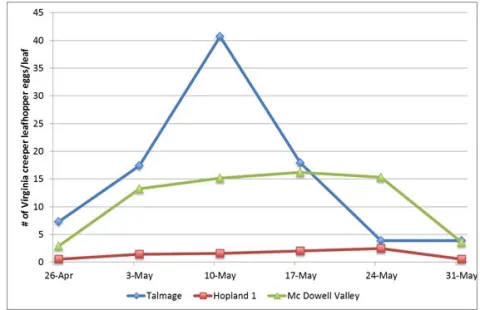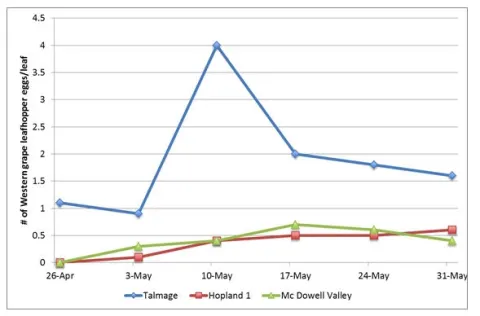Virginia creeper leafhopper and Western grape leafhopper peak egg laying has passed (Fig. 1 & 2). Monitoring efforts during the week of May 14th showed the first emergence of VCLH nymphs for the season (see Table 1 for # VCLH nymphs per leaf). On June 7th we observed nymphs between 1st and 5th instar stage, with the majority of the population between 3rd and 4th stage. Nymph development will continue in the coming weeks, so now is the time to be monitoring nymph populations in your vineyards.
Due to the lack of biological control, effective early-season control of VCLH is critical. Based on monitoring, if control measures are needed, the optimum application period would be when the majority of the population is still in the younger nymphal stages before the emergence of adults. Depending on population levels at your site, a follow-up application may be required to impact nymphs that emerge after the spray. Consult your PCA for materials, rates and timing.
Figure 1. Average number of Virginia creeper leafhopper eggs per leaf at three locations in Mendocino County.

Figure 2. Average number of Western grape leafhopper eggs per leaf at three locations in Mendocino County (Note: the y-axis scale is different from previous graph).

Table 1. Average number of Virginia creeper leafhopper nymphs per leaf at three locations in Mendocino County.
| Average # of VCLH nymphs/leaf | ||
Location | May 24 | May 31 | June 7 |
Talmage 1 | 1.9 | 9.4 | 9.7 |
Hopland 1 | 0.1 | 2.6 | 3.5 |
McDowell Valley | 0.3 | 6.7 | 8.9 |
Ryan Keiffer and Lucia Varela, UCCE, are conducting the 2018 leafhopper monitoring. For more information, please visit the Areawide Virginia Creeper Leafhopper website: http://ucanr.edu/sites/vclh/

